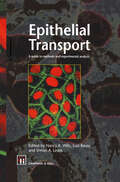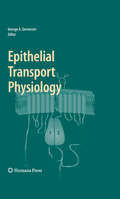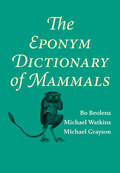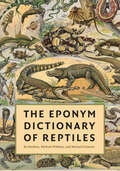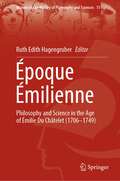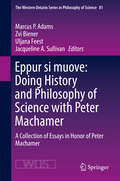- Table View
- List View
Epithelial Transport: A guide to methods and experimental analysis
by N.K. Wills L. Reuss S.A. LewisBuilding from general principles, the authors clearly explain the fundamental role of epithelia in plasma electrolyte and water balance. Emphasis is placed on experimental approaches and methodology. A comprehensive glossary of terms is included.
Epithelial Transport Physiology
by George A. GerencserBiological cell membranes regulate the transfer of matter and information between the intracellular and extracellular compartments as basic survival and maintenance functions for an organism. This volume contains a series of reviews that are c- cerned with how epithelial plasma membranes regulate the transport of solutes between the intracellular and extracellular compartments of a cell. This book is also an attempt to analyze the molecular basis for the movement of various solutes across an epithelial cell membrane. This volume is devoted to a diversity of epithelial transport mechanisms in rep- sentative cell membranes of a variety of living things. The ?rst section of the book (Chapters 1–6) focuses on mechanisms of solute transport in epithelia of inver- brates. The last section which comprises ten chapters (Chapters 7–16) deals with solute transporters in epithelial cell membranes of vertebrates. It is hoped that with this particular ordering the reader can glean a telescopic view of the evolutionary history of the various epithelial solute transporters.
Epithelial—Mesenchymal Interactions in Cancer (Experientia Supplementum #74)
by Itzhak D. Goldberg Eliot M. RosenEpitope Mapping Protocols (Methods in Molecular Biology #524)
by Mike Schutkowski and Ulrich ReinekeGiven the versatile utility of the determinination of epitopes, beneficial to a wide variety of scientists from immunologists to structural biologists to biotechnologists, the need for a thorough, state-of-the-art collection of experimental protocols is clear. In Epitope Mapping Protocols, Second Edition, expert contributors from a broad spectrum of scientific backgrounds update and expand the successful first edition with cutting-edge techniques and applications, including approaches to both antibody or B-cell epitope mapping and T-cell epitope mapping as well as a new section on the profiling of antibody signatures in biological fluids. Written in the popular Methods in Molecular Biology™ series format, chapters include brief introductions to the topics, lists of the necessary materials and reagents, step-by-step, readily reproducible laboratory protocols, and Notes sections, which highlight tips on troubleshooting and avoiding known pitfalls. Comprehensive and up-to-date, Epitope Mapping Protocols, Second Edition is a reliable and valuable reference for all those who wish to understand and further investigate the diversifying field of epitope mapping.
Epitope Mapping Protocols (Methods in Molecular Biology #66)
by Glenn E. MorrisInterest in epitope mapping, or finding out where antibodies bind to their antigens, is by no means restricted to immunologists, but is shared by biolo gists from a wide range of disciplines in which antibodies are used as molecu lar reagents. The epitope mapper may be interested in studying protein-protein interactions, in developing an immunoassay, in producing protective peptide vaccines, in investigating the pathogenesis of autoimmune diseases, or in defining protein topology in intact cells or organelles, to mention only a few of the possibilities. The aim of Epitope Mapping Protocols is to provide both a useful range of alternative practical methods for the experienced mapper and a fairly com prehensive introduction for someone embarking on antibody production and mapping for the first time. Contributors were encouraged to illustrate their protocols with results from their own research and most of them elected to do so. After an introductory chapter, the protocols are arranged in three groups: The first group of twelve methods uses (or can use) whole, native antigens and may therefore be suitable for conformational epitopes; the second group of five uses peptides or peptide libraries; and the third group of eleven requires antigen expressed from recombinant DNA. Within this last group, methods more likely applicable to conformational epitopes are placed first.
Epitranscriptomics (RNA Technologies #12)
by Stefan Jurga Jan BarciszewskiThis book reviews a novel and exciting field of cellular and molecular biology called epitranscriptomics, which focuses on changes in an organism’s cells resulting from the posttranscriptional modification of cellular RNA. RNA-binding proteins (RBPs) play a crucial role in these posttranscriptional modifications and also support several cellular processes necessary for maintaining RNA homeostasis. Exploring the mechanisms underlying RNA modifications and RBP function is an emerging area of biomedical research, taking the study of gene regulation a step beyond epigenetics. This book reveals that the RNA molecule is not just an information-carrying molecule with some secondary structures. Accordingly, how RNA is modified, regulated, packaged, and controlled is an important aspect. Leading experts address questions such as where the over 170 distinct posttranscriptional RNA modifications are located on the genome, what percentage of mRNAs and noncoding RNAs these modifications include, and how an RNA modification impacts a person’s biology. In closing, the book reviews the role of RNA modifications and RBPs in a variety of diseases and their pathogenesis. Addressing some of the most exciting challenges in epitranscriptomics, this book provides a valuable and engaging resource for researchers in academia and industry studying the phenomena of RNA modification.
Epizootic Hemorrhagic Disease Virus: Methods and Protocols (Methods in Molecular Biology #2838)
by Carrie BattenThis volume provides detailed methods to support fast and reliable diagnosis, surveillance and control of Epizootic Haemorrhagic disease virus (EHDV), with the aim of facilitating and promoting further research into this understudied Orbivirus. Chapters guide readers through methods to enable the characterization of EHDV in vitro and in vivo. Written in the highly successful Methods in Molecular Biology series format, chapters include introductions to their respective topics, lists of the necessary materials and reagents, step-by-step, readily reproducible laboratory protocols, and key tips on troubleshooting and avoiding known pitfalls. Authoritative and cutting-edge, Epizootic Hemorrhagic Disease Virus: Methods and Protocols aims to be a useful up-to-date reference work for researchers currently in the field and to those entering the field.
The Epoch of Galaxy Formation (Nato Science Series C: #264)
by Carlos S. Frenk Richard S. Ellis T. Shanks Alan F. Heavens John A. PeacockScientists in the late twentieth century are not the first to view galaxy formation as a phenomenon worthy of explanation in terms of the known laws of physics. Already in 1754 Kant regarded the problem as essentially solved. In his Univerlal Natural Hutory and Theory 0/ the H eaven$ he wrote; "If in the immesurable space in which all the suns of the Milky Way have formed themselves, we assume a point around which, through some cause or other, the first formation of nature out of chaoo began, there the largest mass and a body of extraordinary attraction will have arisen which has thereby become capable of compelling all the systems in the process of being formed within an enormous sphere around it, to fall towards itself as their centre, and to build up a system around it on the great scale . . . . Observation puts this conjecture almost beyond doubt. " More than 200 years later, a similar note of confidence was voiced by Zel'dovicb at an IAU symposium held in Tallin in 1911; "Extrapolating . . . to the next symposium somewhere in the early eighties one can be pretty sure that the question of the formation of galaxies and clusters will be solved in the next few years. " Perhaps few astronomers today would share Kant's near certainty or feel that Zel'dovich's prophecy has been fulfilled, Many, however, will sympathize with the optimistic olltlook of these two statements.
The Epochal Event: Transformations in the Entangled Human, Technological, and Natural Worlds (Palgrave Studies in the History of Science and Technology)
by Zoltán Boldizsár SimonThis book is a unique attempt to capture the growing societal experience of living in an age unlike anything the world has ever seen. Fueled by the perception of acquiring unprecedented powers through technologies that entangle the human and the natural worlds, human beings have become agents of a new kind of transformative event. The ongoing sixth mass extinction of species, the prospect of a technological singularity, and the potential crossing of planetary boundaries are expected to trigger transformations on a planetary scale that we deem catastrophic and try to avoid. In making sense of these prospects, Simon’s book sketches the rise of a new epochal thinking, introduces the epochal event as an emerging category of a renewed historical thought, and makes the case for the necessity of bringing together the work of the human and the natural sciences in developing knowledge of a more-than-human world.
The Epochs of Nature
by Georges-Louis LeclercGeorges-Louis Leclerc, le comte de Buffon's The Epochs of Nature, originally published as Les Époques de la Nature in 1778, is one of the first great popular science books, a work of style and insight that was devoured by Catherine the Great of Russia and influenced Humboldt, Darwin, Lyell, Vernadsky, and many other renowned scientists. It is the first geological history of the world, stretching from the Earth’s origins to its foreseen end, and though Buffon was limited by the scientific knowledge of his era—the substance of the Earth was not, as he asserts, dragged out of the sun by a giant comet, nor is the sun’s heat generated by tidal forces—many of his deductions appear today as startling insights. And yet, The Epochs of Nature has never before been available in its entirety in English—until now. In seven epochs, Buffon reveals the main features of an evolving Earth, from its hard rock substrate to the sedimentary layers on top, from the minerals and fossils found within these layers to volcanoes, earthquakes, and rises and falls in sea level—and he even touches on age-old mysteries like why the sun shines. In one of many moments of striking scientific prescience, Buffon details evidence for species extinction a generation before Cuvier’s more famous assertion of the phenomenon. His seventh and final epoch does nothing less than offer the first geological glimpse of the idea that humans are altering the very foundations of the Earth—an idea of remarkable resonance as we debate the designation of another epoch: the Anthropocene. Also featuring Buffon’s extensive “Notes Justificatives,” in which he offers further evidence to support his assertions (and discusses vanished monstrous North American beasts—what we know as mastodons—as well as the potential existence of human giants), plus an enlightening introduction by editor and translator Jan Zalasiewicz and historians of science Sverker Sörlin, Libby Robin, and Jacques Grinevald, this extraordinary new translation revives Buffon’s quite literally groundbreaking work for a new age.
The Epochs of Nature
by Georges-Louis LeclercGeorges-Louis Leclerc, le comte de Buffon's The Epochs of Nature, originally published as Les Époques de la Nature in 1778, is one of the first great popular science books, a work of style and insight that was devoured by Catherine the Great of Russia and influenced Humboldt, Darwin, Lyell, Vernadsky, and many other renowned scientists. It is the first geological history of the world, stretching from the Earth’s origins to its foreseen end, and though Buffon was limited by the scientific knowledge of his era—the substance of the Earth was not, as he asserts, dragged out of the sun by a giant comet, nor is the sun’s heat generated by tidal forces—many of his deductions appear today as startling insights. And yet, The Epochs of Nature has never before been available in its entirety in English—until now. In seven epochs, Buffon reveals the main features of an evolving Earth, from its hard rock substrate to the sedimentary layers on top, from the minerals and fossils found within these layers to volcanoes, earthquakes, and rises and falls in sea level—and he even touches on age-old mysteries like why the sun shines. In one of many moments of striking scientific prescience, Buffon details evidence for species extinction a generation before Cuvier’s more famous assertion of the phenomenon. His seventh and final epoch does nothing less than offer the first geological glimpse of the idea that humans are altering the very foundations of the Earth—an idea of remarkable resonance as we debate the designation of another epoch: the Anthropocene. Also featuring Buffon’s extensive “Notes Justificatives,” in which he offers further evidence to support his assertions (and discusses vanished monstrous North American beasts—what we know as mastodons—as well as the potential existence of human giants), plus an enlightening introduction by editor and translator Jan Zalasiewicz and historians of science Sverker Sörlin, Libby Robin, and Jacques Grinevald, this extraordinary new translation revives Buffon’s quite literally groundbreaking work for a new age.
The Epochs of Nature
by Georges-Louis LeclercGeorges-Louis Leclerc, le comte de Buffon's The Epochs of Nature, originally published as Les Époques de la Nature in 1778, is one of the first great popular science books, a work of style and insight that was devoured by Catherine the Great of Russia and influenced Humboldt, Darwin, Lyell, Vernadsky, and many other renowned scientists. It is the first geological history of the world, stretching from the Earth’s origins to its foreseen end, and though Buffon was limited by the scientific knowledge of his era—the substance of the Earth was not, as he asserts, dragged out of the sun by a giant comet, nor is the sun’s heat generated by tidal forces—many of his deductions appear today as startling insights. And yet, The Epochs of Nature has never before been available in its entirety in English—until now. In seven epochs, Buffon reveals the main features of an evolving Earth, from its hard rock substrate to the sedimentary layers on top, from the minerals and fossils found within these layers to volcanoes, earthquakes, and rises and falls in sea level—and he even touches on age-old mysteries like why the sun shines. In one of many moments of striking scientific prescience, Buffon details evidence for species extinction a generation before Cuvier’s more famous assertion of the phenomenon. His seventh and final epoch does nothing less than offer the first geological glimpse of the idea that humans are altering the very foundations of the Earth—an idea of remarkable resonance as we debate the designation of another epoch: the Anthropocene. Also featuring Buffon’s extensive “Notes Justificatives,” in which he offers further evidence to support his assertions (and discusses vanished monstrous North American beasts—what we know as mastodons—as well as the potential existence of human giants), plus an enlightening introduction by editor and translator Jan Zalasiewicz and historians of science Sverker Sörlin, Libby Robin, and Jacques Grinevald, this extraordinary new translation revives Buffon’s quite literally groundbreaking work for a new age.
The Epochs of Nature
by Georges-Louis LeclercGeorges-Louis Leclerc, le comte de Buffon's The Epochs of Nature, originally published as Les Époques de la Nature in 1778, is one of the first great popular science books, a work of style and insight that was devoured by Catherine the Great of Russia and influenced Humboldt, Darwin, Lyell, Vernadsky, and many other renowned scientists. It is the first geological history of the world, stretching from the Earth’s origins to its foreseen end, and though Buffon was limited by the scientific knowledge of his era—the substance of the Earth was not, as he asserts, dragged out of the sun by a giant comet, nor is the sun’s heat generated by tidal forces—many of his deductions appear today as startling insights. And yet, The Epochs of Nature has never before been available in its entirety in English—until now. In seven epochs, Buffon reveals the main features of an evolving Earth, from its hard rock substrate to the sedimentary layers on top, from the minerals and fossils found within these layers to volcanoes, earthquakes, and rises and falls in sea level—and he even touches on age-old mysteries like why the sun shines. In one of many moments of striking scientific prescience, Buffon details evidence for species extinction a generation before Cuvier’s more famous assertion of the phenomenon. His seventh and final epoch does nothing less than offer the first geological glimpse of the idea that humans are altering the very foundations of the Earth—an idea of remarkable resonance as we debate the designation of another epoch: the Anthropocene. Also featuring Buffon’s extensive “Notes Justificatives,” in which he offers further evidence to support his assertions (and discusses vanished monstrous North American beasts—what we know as mastodons—as well as the potential existence of human giants), plus an enlightening introduction by editor and translator Jan Zalasiewicz and historians of science Sverker Sörlin, Libby Robin, and Jacques Grinevald, this extraordinary new translation revives Buffon’s quite literally groundbreaking work for a new age.
The Eponym Dictionary of Mammals
by Michael Watkins Bo Beolens Michael GraysonJust who was the Przewalski after whom Przewalski's horse was named? Or Husson, the eponym for the rat Hydromys hussoni? Or the Geoffroy whose name is forever linked to Geoffroy's cat? This unique reference provides a brief look at the real lives behind the scientific and vernacular mammal names one encounters in field guides, textbooks, journal articles, and other scholarly works.Arranged to mirror standard dictionaries, the more than 1,300 entries included here explain the origins of over 2,000 mammal species names. Each bio-sketch lists the scientific and common-language names of all species named after the person, outlines the individual's major contributions to mammalogy and other branches of zoology, and includes brief information about his or her mammalian namesake's distribution. The two appendixes list scientific and common names for ease of reference, and, where appropriate, individual entries include mammals commonly—but mistakenly—believed to be named after people.The Eponym Dictionary of Mammals is a highly readable and informative guide to the people whose names are immortalized in mammal nomenclature.
The Eponym Dictionary of Reptiles
by Bo Beolens Michael Watkins Michael GraysonWho was Richard Kemp, after whom the Kemp’s ridley sea turtle is named? Is Wake’s Gecko named after Berkeley’s Marvalee Wake? Or perhaps her husband, David? Why do so many snakes and lizards have Werner in their name? This reference book answers these and thousands of other questions about the origins of the vernacular and scientific names of reptiles across the globe.From Agkistrodon piscivorus conanti, the Florida cottonmouth subspecies named for Roger Conant, to Xantusia, the night lizard genera namesake of John Xantus, this dictionary covers everyone after whom an extant or recently extinct reptile has been named. The entries include a brief bio-sketch, a list of the reptiles that bear the individual’s name, the names of reptiles erroneously thought to be associated with the person, and a summary of major—and sometimes obscure or even incidental—contributions made by the person to herpetology and zoology. An introductory chapter explains how to use the book and describes the process of naming taxa. Easy to use and filled with addictive—and highly useful—information about the people whose names will be carried into the future on the backs of the world’s reptiles, The Eponym Dictionary of Reptiles is a handy and fun book for professional and amateur herpetologists alike.
The Eponym Dictionary of Reptiles
by Michael Watkins Bo Beolens Michael GraysonWho was Richard Kemp, after whom the Kemp’s ridley sea turtle is named? Is Wake’s Gecko named after Berkeley’s Marvalee Wake? Or perhaps her husband, David? Why do so many snakes and lizards have Werner in their name? This reference book answers these and thousands of other questions about the origins of the vernacular and scientific names of reptiles across the globe.From Agkistrodon piscivorus conanti, the Florida cottonmouth subspecies named for Roger Conant, to Xantusia, the night lizard genera namesake of John Xantus, this dictionary covers everyone after whom an extant or recently extinct reptile has been named. The entries include a brief bio-sketch, a list of the reptiles that bear the individual’s name, the names of reptiles erroneously thought to be associated with the person, and a summary of major—and sometimes obscure or even incidental—contributions made by the person to herpetology and zoology. An introductory chapter explains how to use the book and describes the process of naming taxa. Easy to use and filled with addictive—and highly useful—information about the people whose names will be carried into the future on the backs of the world’s reptiles, The Eponym Dictionary of Reptiles is a handy and fun book for professional and amateur herpetologists alike.
Époque Émilienne: Philosophy and Science in the Age of Émilie Du Châtelet (1706-1749) (Women in the History of Philosophy and Sciences #11)
by Ruth Edith HagengruberThe present book contextualizes Du Châtelet’s contribution to the philosophy of her time. The editor offers this tribute to an Époque Émiliennee as a collection of innovative papers on Emilie Du Châtelet’s powerful philosophy and legacy.Du Châtelet was an outstanding figure in the era she lived in. Her work and achievements were unique, though not an exception in the 18th century, which did not lack outstanding women. Her personal intellectual education, her scholarly network and her mental acumen were celebrated in her time, perceiving her to have “multiplied nine figures by nine figures in her head”. She was able to gain access to institutions which were normally denied to women. To call an epoch an Époque Émilienne may be seen as daring and audacious, but it will not be the last time if we continue to bring women philosophers back into the memory of the history of philosophy. The contributors paid attention to the philosophical state of the art, which forms the background to Du Châtelet’s philosophy. They follow the transformation of philosophical concepts under her pen and retrace the impact of her ideas. The book is of interest to scholars working in the history of philosophy as well as in gender studies. It is of special interest for scholars working on the 18th century, Kant, Leibniz, Wolff, Newton and the European Enlightenment.
The Epothilones: From Soil to the Clinic (Fortschritte der Chemie organischer Naturstoffe Progress in the Chemistry of Organic Natural Products #90)
by Karl-Heinz Altmann A. Douglas Kinghorn Gerhard Höfle Rolf Müller Kathrin PrantzEpothilones have received unusual attention over the past ten years. They are novel antitumor drugs which very much like their predecessor paclitaxel (Taxol) act via microtubule stabilization. In comparison to paclitaxel and a number of alternative drugs with a similar mode of bioaction (e.g. laulimalide, eleutherobin, peluroside, discodermolide) the epothilones have significant advantages, above all very high activity in the nanomolar range and low susceptibility towards multidrug resistance. Epothilone B and several derivatives thereof are in phase I-III clinical trials; one of them (ixabepilone, BMS) is already on the market, others are supposed to appear on the market in the near future. All naturally occurring epothilones have been isolated from Sorangium cellulosum; their antitumor action is traced back to the stabilization of microtubules. In consequence, the formation of the mitototic spindle is prohibited and the cell undergoes apoptosis.
Epoxidations and Hydroperoxidations of α,β-Unsaturated Ketones: An Approach through Asymmetric Organocatalysis (Springer Theses)
by Corinna ReisingerCorinna Reisinger has developed a new organocatalytic asymmetric epoxidation of cyclic and acyclic α,β-unsaturated ketones. In this thesis, Corinna documents her methodology, using primary amine salts as catalysts, and hydrogen peroxide as an inexpensive and environmentally benign oxidant. She describes the unprecedented and powerful catalytic asymmetric hydroperoxidation of α,β-enones, a process which produces optically active five-membered cyclic peroxyhemiketals in a single operation. She also proves the versatility and synthetic value of the cyclic peroxyhemiketals by converting them into highly enantioenriched acyclic and cyclic aldol products. Currently, these cyclic aldol products are inaccessible by any other synthetic means. Furthermore, cyclic peroxyhemiketals are precursors to optically active 1,2-dioxolanes which are of biological relevance. This work is a breakthrough in the field of asymmetric epoxidation chemistry and outlines the most efficient method in the literature for generating highly enantioselective cyclic epoxyketones known to date.
Epoxidised Natural Rubber: Properties & Applications
by Siti Salina Sarkawi Fatimah Rubaizah Mohd Rasdi Veronica CharlotteThis book is a complete guide to epoxidized natural rubber covering from the epoxidation chemistry, production process, raw rubber and compound properties, mixing recommendations as its applications in tire, engineering, general and industrial rubber goods, latex based products such as adhesive, foam and paint as well as sustainability or life cycle analysis of ENR rubber. Hence, it is useful for readers either from the industry which looking for specific product application and properties, or scientists and academicians working on their research using the ENR in their study for reference and guidance.
Epoxy Resins: Chemistry and Technology, Second Edition,
by Clayton MayFeaturing new techniques of physicochemical analysis and broader coverage of textile applications,the thoroughly rewritten and enlarged Second Edition provides hands-on assistance inthe use, formulation, synthesis, processing, and handling of epoxy resins.Epoxy Resins, Second Edition, Revised and Expanded documents available commercialproducts, including rarer species of epoxides ... shows how to achieve qualityassurance through analytical methods ... discusses toxicity, hazards, and safe handling ...looks closely at elastomer modification of resins as well as adhesives, coatings, electrical andelectronic applications, fiber-reinforced composites, and the use of epoxy resins in thestabilization of polymers, plasticizers, and textiles ... and assists in the more efficientselection and application of epoxy resins.Complete with nearly 300 pages of tables for quick references, plus over 300 diagrams andphotographs, and more than 4,400 bibliographic references, this volume will proveindispensable to polymer, physical, and organic chemists, rheologists, materials scientists andengineers, and chemical, plastics, aerospace, automotive, and electrical and electronicsengineers.
Epoxy Resins: Chemistry and Technology, Second Edition,
by Clayton A. MayFeaturing new techniques of physicochemical analysis and broader coverage of textile applications,the thoroughly rewritten and enlarged Second Edition provides hands-on assistance inthe use, formulation, synthesis, processing, and handling of epoxy resins.Epoxy Resins, Second Edition, Revised and Expanded documents available commercialproducts, including rarer species of epoxides ... shows how to achieve qualityassurance through analytical methods ... discusses toxicity, hazards, and safe handling ...looks closely at elastomer modification of resins as well as adhesives, coatings, electrical andelectronic applications, fiber-reinforced composites, and the use of epoxy resins in thestabilization of polymers, plasticizers, and textiles ... and assists in the more efficientselection and application of epoxy resins.Complete with nearly 300 pages of tables for quick references, plus over 300 diagrams andphotographs, and more than 4,400 bibliographic references, this volume will proveindispensable to polymer, physical, and organic chemists, rheologists, materials scientists andengineers, and chemical, plastics, aerospace, automotive, and electrical and electronicsengineers.
Epoxydverbindungen und Epoxydharze (Chemische Technologie der Kunststoffe in Einzeldarstellungen)
by Alfred M. PaquinEppur si muove: A Collection of Essays in Honor of Peter Machamer (The Western Ontario Series in Philosophy of Science #81)
by Marcus P. Adams Zvi Biener Uljana Feest Jacqueline A. SullivanThis volume is a collection of original essays focusing on a wide range of topics in the History and Philosophy of Science. It is a festschrift for Peter Machamer, which includes contributions from scholars who, at one time or another, were his students. The essays bring together analyses of issues and debates spanning from early modern science and philosophy through the 21st century. Machamer’s influence is reflected in the volume’s broad range of topics. These include: underdetermination, scientific practice, scientific models, mechanistic explanation in contemporary and historical science, values in science, the relationship between philosophy and psychology, experimentation, supervenience and reductionism.
